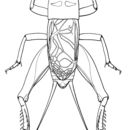en
names in breadcrumbs


Short-tailed crickets are light-brown, burrowing crickets that owe their common and scientific names to their vestigial ovipositors (an-uro-gryllus, in English, is no-tail-cricket). Short-tailed crickets excavate burrows by carrying dirt to the surface in their mandibles. The completed burrow has one or more living chambers and a tunnel for defecation. Except for dispersing, foraging, and mate-finding, short-tailed crickets spend their entire lives underground in their burrows.
Females use their vestigial ovipositors to lay eggs in a pile on the floor of a burrow chamber. They may mouth and move the eggs about but do not eat them. When the eggs hatch, the juveniles are fed by their mother for about a month. They then leave their mother's burrow, disperse a few meters, and dig burrows of their own.
Except for a mother and her young, and, briefly, for some matings, short-tailed crickets live alone. Unless the occupant is out or preparing to go out, the burrow entrance is kept plugged with dirt or plant material.
Some taxonomists place Anurogryllus and other crickets that are similarly adapted for living in burrows in a subfamily of their own, the Brachytrupinae (e.g., Otte 1994). Whether they are considered to be one subfamily or two, crickets that are placed in Gryllinae and Brachytrupinae apparently form a monophyletic group (Gwynne 1995).
Anurogryllus arboreus is the only U.S. species of short-tailed cricket, except on the Florida Keys where Anurogryllus celerinictus occurs as well. The reproductive behavior of short-tailed crickets has been studied extensively.
"
"
Anurogryllus, commonly known as short-tailed crickets, is a genus of crickets in the tribe Gryllini; species are recorded from the Americas.[1] The common and scientific names derive from the vestigial, poorly developed ovipositors of females.[2][3]
The Orthoptera Species File database lists the following species:[1]
Anurogryllus, commonly known as short-tailed crickets, is a genus of crickets in the tribe Gryllini; species are recorded from the Americas. The common and scientific names derive from the vestigial, poorly developed ovipositors of females.